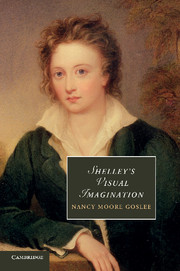Book contents
- Frontmatter
- Contents
- List of illustrations
- Acknowledgments
- 1 Introduction: text and figure
- 2 Mab's metamorphoses
- 3 “Hymn to Intellectual Beauty”: visual texts, invisible figure
- 4 “Clear elemental shapes”: communicating Greek liberty in Laon and Cythna
- 5 Anarchy's textual progress: representing liberty
- 6 Refiguring genre in Shelley's “Ode to Liberty”
- 7 Dispersoning Emily: drafting as plot in Epipsychidion
- 8 “Compelling / All new successions”: death and the poet's figurations in Adonais
- 9 The Triumph of Life: figure, history, and inscription
- Notes
- Bibliography
- Index
- CAMBRIDGE STUDIES IN ROMANTICISM
1 - Introduction: text and figure
Published online by Cambridge University Press: 05 March 2014
- Frontmatter
- Contents
- List of illustrations
- Acknowledgments
- 1 Introduction: text and figure
- 2 Mab's metamorphoses
- 3 “Hymn to Intellectual Beauty”: visual texts, invisible figure
- 4 “Clear elemental shapes”: communicating Greek liberty in Laon and Cythna
- 5 Anarchy's textual progress: representing liberty
- 6 Refiguring genre in Shelley's “Ode to Liberty”
- 7 Dispersoning Emily: drafting as plot in Epipsychidion
- 8 “Compelling / All new successions”: death and the poet's figurations in Adonais
- 9 The Triumph of Life: figure, history, and inscription
- Notes
- Bibliography
- Index
- CAMBRIDGE STUDIES IN ROMANTICISM
Summary
CHALLENGING ROMANTIC ICONOPHOBIA: THE CASE OF SHELLEY
In Act ii of Prometheus Unbound, Shelley's oracular character Demogorgon responds to Asia's questions about a supreme deity by asserting with skeptical conciseness that, “A voice / Is wanting, the deep truth is imageless.” A brilliant revision of Milton's account of Death and Burke's praise of that account as a model of verbal sublimity, Demogorgon's own voice emerges from the “deep” of his volcanic cave while Asia and her sister can see only a “mighty Darkness,” “Ungazed upon and shapeless,” a darkness possessing “neither limb / Nor form nor outline.” Shelley thus tempts critics into making the second half of Demogorgon's utterance a guide for interpreting not only this lyrical drama, but all of his poetry, as a skeptical attack upon both the aesthetic medium and the philosophic implications of visuality. Further, Romanticists have repeatedly invoked that phrase, “the deep truth is imageless,” to characterize Romantic poetry more generally as a turning away from the “mirror” or mimesis of an objective world or its transcendent structures to the voice or music of an expressive subject.
So pervasive has been this focus upon the second half of Demogorgon's assertion that W. J. T. Mitchell quotes it to characterize what he calls the “iconophobic” or anti-visual tendency of Romanticism.
- Type
- Chapter
- Information
- Shelley's Visual Imagination , pp. 1 - 27Publisher: Cambridge University PressPrint publication year: 2011



